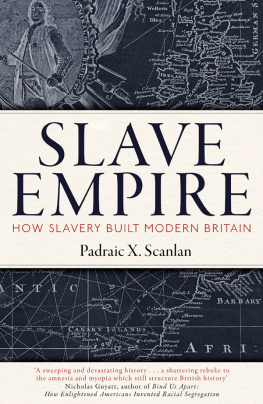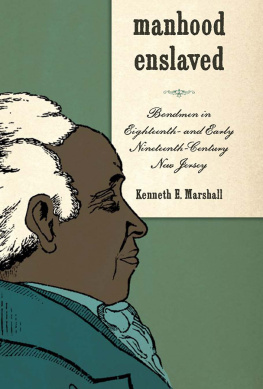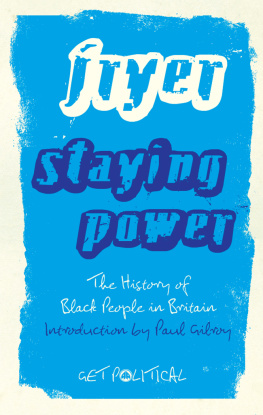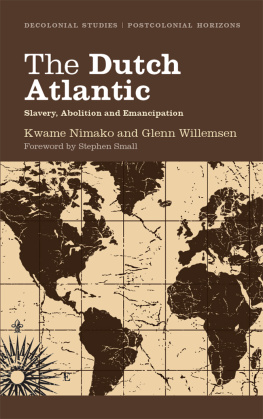A MARINER BOOK
HOUGHTON MIFFLIN COMPANY
BOSTON NEW YORK
For
Patricia H. Labalme
(19272002)
First Mariner Books edition 2006
Copyright 2005 by Adam Hochschild
All rights reserved
For information about permission to reproduce selections from
this book, write to Permissions, Houghton Mifflin Company,
215 Park Avenue South, New York, New York 10003.
Visit our Web site: www.houghtonmifflinbooks.com.
Library of Congress Cataloging-in-Publication Data
Hochschild, Adam.
Bury the chains : prophets and rebels in the fight to free an
empire's slaves / Adam Hochschild.
p. cm.
Includes bibliographical references and index.
ISBN -13: 978-0-618-10469-7 ISBN -10: 0-618-10469-0
ISBN -13: 978-0-618-61907-8 (pbk.) ISBN -10: 0-618-61907-0 (pbk.)
1. Antislavery movementsGreat BritainHistory
18th century. 2. Antislavery movementsGreat Britain
History 19th century. I. Title.
HT 1163. H 63 2004
326'.8'0941dc22 2004054091
Book design by Melissa Lotfy
Printed in the United States of America
MP 10 9 8 7 6 5 4 3 2 1
Portions of this book previously appeared, in somewhat different form,
in Mother Jones and the San Francisco Chronicle Magazine.
CONTENTS
Introduction: Twelve Men in a Printing Shop 1
PART I: WORLD OF BONDAGE
1. Many Golden Dreams
2. Atlantic Wanderer
3. Intoxicated with Liberty
4. King Sugar
5. A Tale of Two Ships
PART II: FROM TINDER TO FLAME
6. A Moral Steam Engine
7. The First Emancipation
8. "I Questioned Whether I Should Even Get Out of It Alive"
9. Am I Not a Man and a Brother?
10. A Place Beyond the Seas
11. "Ramsay Is DeadI Have Killed Him"
PART III: "A WHOLE NATION CRYING WITH ONE VOICE "
12. An Eighteenth-Century Book Tour
13. The Blood-Sweetened Beverage
14. Promised Land
15. The Sweets of Liberty
16. High Noon in Parliament
PART IV: WAR AND REVOLUTION
17. Bleak Decade
18. At the Foot of Vesuvius
19. Redcoats' Graveyard
20. "These Gilded Africans"
PART V: BURY THE CHAINS
21. A Side Wind
22. Am I Not a Woman and a Sister?
23. "Come, Shout o'er the Grave"
Epilogue: "To Feel a Just Indignation"
Appendix: Where was Equiano Born?
Source Notes
Bibliography
Acknowledgments
Index
Note
In quoting letters, newspapers, documents, and other primary sources, I have retained the original spelling and punctuation, including the eighteenth-century habit of scattering about commas, capital letters, and italics far more profligately than we do now.
Giving the equivalents in today's currency to sums of money from two hundred years ago is a matter far from precise, since money then and now bought or buys different things. A Londoner of the 1700s could not buy a computer; one of today cannot buy a stagecoach ticket to Bath. However, to the extent that we can make comparisons, 1 in 1787 had the purchasing power of approximately $140 as this book went to press. My apparent departures from this rule of thumb stem from the decline in the value of the pound over time, and from the fact that the pound used in the various British West Indian islands was worth somewhat less than the British pound.
INTRODUCTION: TWELVE MEN IN A PRINTING SHOP
S TRANGELY, in a city where it seems that on almost every block a famous event or resident is commemorated by a blue and white glazed plaque, none marks this spot. All you can see today, after you leave the Bank station of the London Underground, walk several blocks, and then take a few steps into a courtyard, are a few low, nondescript office buildings, an ancient pub, and, on the site itself, 2 George Yard, a glass and steel high-rise. Nothing remains of the bookstore and printing shop that once stood here, or recalls the spring day more than two hundred years ago when a dozen peoplea somber-looking crew, most of them not removing their high-crowned black hatsfiled through its door and sat down for a meeting. Cities build monuments to kings, prime ministers, and generals, not to citizens with no official position who once gathered in a printing shop. Yet what these citizens began rippled across the world and we feel its aftereffects still. It is no wonder that they won the admiration of the first and greatest student of what we now call civil society. The result of the series of events begun that afternoon in London, wrote Alexis de Tocqueville, was "absolutely without precedent.... If you pore over the histories of all peoples, I doubt that you will find anything more extraordinary."
To understand how momentous was this beginning, we must picture a world in which the vast majority of people are prisoners. Most of them have known no other way of life. They are not free to live or go where they want. They plant, cultivate, and harvest most of the earth's major crops. They earn no money from their labor. Their work often lasts twelve or fourteen hours a day. Many are subject to cruel whippings or other punishments if they do not work hard enough. They die young. They are not chained or bound most of the time, but they are in bondage, part of a global economy based on forced labor. Such a world would, of course, be unthinkable today.
But this was the worldour worldjust two centuries ago, and to most people then, it was unthinkable that it could ever be otherwise. At the end of the eighteenth century, well over three quarters of all people alive were in bondage of one kind or another, not the captivity of striped prison uniforms, but of various systems of slavery or serfdom. The age was a high point in the trade in which close to eighty thousand chained and shackled Africans were loaded onto slave ships and transported to the New World each year. In parts of the Americas, slaves far outnumbered free persons. The same was true in parts of Africa, and it was from these millions of indigenous slaves that African chiefs and slave dealers drew most of the men and women they sold to Europeans and Arabs sailing their ships along the continent's coasts. African slaves were spread throughout the Islamic world, and the Ottoman Empire enslaved other peoples as well. In India and other parts of Asia, tens of millions of farmworkers were in outright slavery, and others were peasants in debt bondage that tied them and their labor to a particular landlord as harshly as any slave was bound to a plantation owner in South Carolina or Georgia. Native Americans turned prisoners of war into slaves and sold them, both to neighboring tribes and to the Europeans now pushing their way across the continent. In Russia the majority of the population were serfs, often bought, sold, whipped, or sent to the army at the will of their owners.
The era was one when, as the historian Seymour Drescher puts it, "freedom, not slavery, was the peculiar institution." This world of bondage seemed all the more normal then, because anyone looking back in time would have seen little but other slave systems. The ancient Greeks had slaves; the Romans had an estimated two to three million of them in Italy alone; the Incas and Aztecs had slaves; the sacred texts of most major religions took slavery for granted. Slavery had existed before money or written law.
One measure of how much slavery pervaded the world of the eighteenth century is the traffic on the Atlantic Ocean. We usually think of the Atlantic of this period as being filled with shiploads of hopeful white immigrants. But they were only a minority of those carried to the New World. So rapidly were slaves worked to death, above all on the brutal sugar plantations of the Caribbean, that between 1660 and 1807, ships brought well over three times as many Africans across the ocean to British colonies as they did Europeans. And, of course, it was not just to British territories that slaves were sent. From Senegal to Virginia, Sierra Leone to Charleston, the Niger delta to Cuba, Angola to Brazil, and on dozens upon dozens of crisscrossing paths taken by thousands of vessels, the Atlantic was a conveyor belt to early death in the fields of an immense swath of plantations that stretched from Baltimore to Rio de Janeiro and beyond.
Next page







